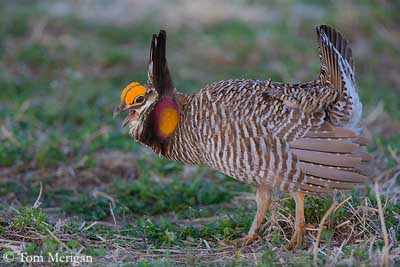
Greater Prairie Chicken
Tympanuchus cupido
Galliforme Order – Tetraonidae Family
BIOMETRICS :
Length : 41-47 cm
Weight : M : 900g – F : 770 g
LONGEVITY: Up to 2-3 years in wild
DESCRIPTION:
Greater Prairie Chicken is a grouse of open areas, well known for its displays at leks, and mainly for its spectacular mating-dance.

Adult male is a stocky bird with rounded wings and short tail. Its plumage is brown, heavily barred white overall. On the short, rounded tail, rectrices are blackish. Undertail feathers are white, spotted brown. Belly and vent are white.
We can see elongated feathers on neck-sides. These blackish feathers are erected during the displays, as two pointed ears.
On the head, two yellow-orange combs above the eyes become brighter during the displays, and the small feathers are erected too.
In addition, two naked orange neck patches are situated under the elongated feathers. During the displays, the bird inflates these vocal “sacs” which become very conspicuous. Chin and throat are white.
The bill is brownish. Eyes are brown. Strong legs and feet are yellowish-brown. Legs are feathered.
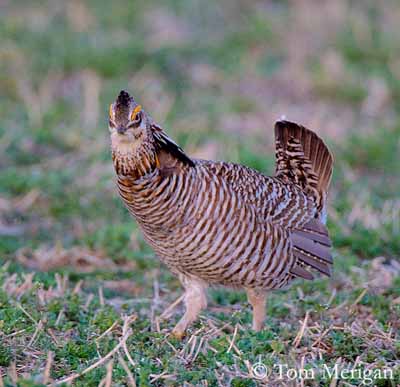
The female is slightly different. She has brown plumage extensively barred white, including rectrices and flight feathers. The head ornaments are smaller and paler.
Immature is similar to female, with the two outer primaries pointed.
The juvenile has strongly streaked scapulars.
We find three subspecies:
T.c. pinnatus, from Dakota, Nebraska, Kansas and Missouri.
T.c. attwateri, from the coastal areas of Texas.
T.c. cupido, extinct since 1932. It ranged along the eastern US coasts.
VOICE: SOUNDS BY XENO-CANTO
Greater Prairie Chicken uses the vocal sacs during courtship displays. The bird inflates the sacs in order to produce characteristic sounds. We can also hear grunts, hisses and cackles.
Non vocal sounds are produced by the wings, tail or bill, according to the species and the moment.
This species produces “whoop-calls”, cackles and booming calls.
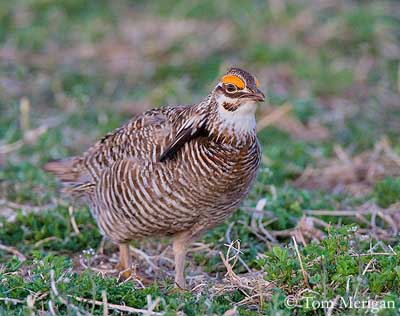
HABITAT:
Greater Prairie Chicken frequents open grasslands and oak woodlands. This species prefers the scrub oaks mixed with prairies, and sandy soils. They need areas of native plants for breeding and roosting. The leks are situated in short-grass areas, on elevated grounds. They nest in tall grassy places.
RANGE:
Greater Prairie Chicken is found today in restricted range in Kansas, Nebraska and South Dakota (race pinnatus), and some places in SE Texas (race attwateri).
BEHAVIOUR:
Greater Prairie Chicken feeds mainly on vegetation such as leaves, buds, seeds and fruits. During the summer, it may consume grasshoppers. They forage in the early morning and in the late afternoon.
The numerous changes in the original habitat also changed the food of this species. In winter, they feed on cultivated grain in many locations. They feed on varied plants’ species all year round. Young are fed on insects.
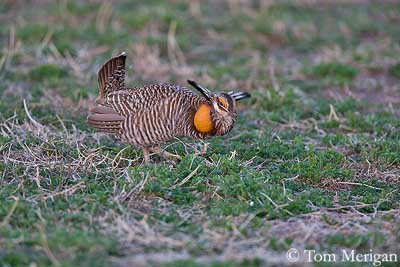
The Greater Prairie Chicken is mainly known for its wonderful displays. When the spring is coming, males gather at leks for displaying. Each male has its own territory in the lek, and it defends strongly this area.
Males fight for these territories, and finally, one or two males become dominant. They jump face to face and crouch alternately, before to jump again.

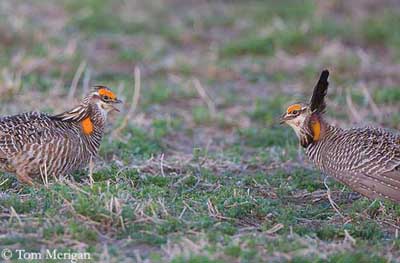
During the displays, males inflate the orange vocal sacs on the neck sides, and perform mating-dances, stamping their feet on the ground and giving booming sounds and cackles. At the same time, the blackish elongated feathers are erected.
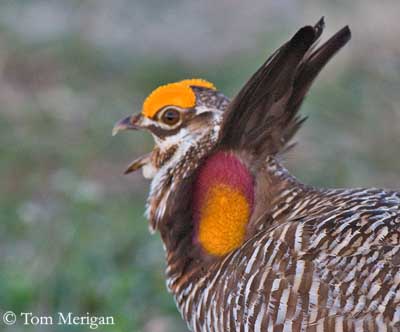
When a female approaches, the male displays around her and stamps its feet while it moves laterally. Wings are dropped on the body sides and the tail is erected, exposing the undertail feathers.
All these displays are accompanied by booming calls and cackles.
Then, after mating, the female builds the nest. Male does not take part to the nesting duties.
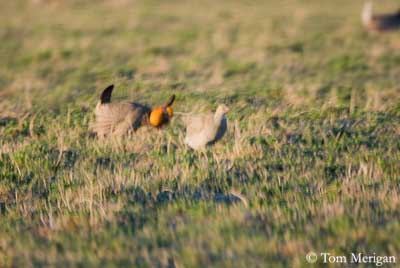
Greater Prairie Chicken is usually sedentary. However, female and young birds may move in erratic way between wintering and breeding areas.
FLIGHT:
Greater Prairie Chicken takes off noisily, with series of rapid wing beats. The powerful pectoral muscles allow intense bursts of effort.
The flight is usually short, and after the noisy take off, it continues with fast glides on down-curved wings.
REPRODUCTION:
Greater Prairie Chicken breeds between mid-April and early June.
The nest is situated in tall grass cover. It is bowl-shaped and lined with soft materials such as dry grass, leaves, twigs and feathers.
Female lays 4 to 15 eggs (usually 12). Incubation lasts about 23-25 days by female alone. The chicks are precocial and follow their mother very soon. She feeds them with insects. The young remain with the female for 8 to 10 weeks. They are able to fly short distances at 15 days of age. They reach their sexual maturity at one year.
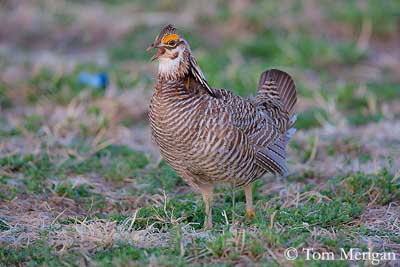
DIET:
Greater Prairie Chicken feeds mainly on plant matter such as leaves, buds, seeds, fruits, and cultivated grains. During the summer, they also consume insects such as grasshoppers.
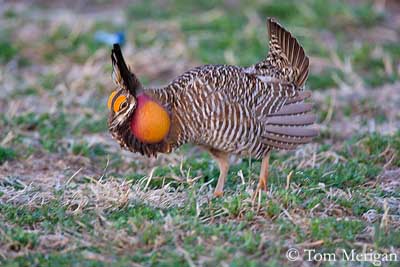
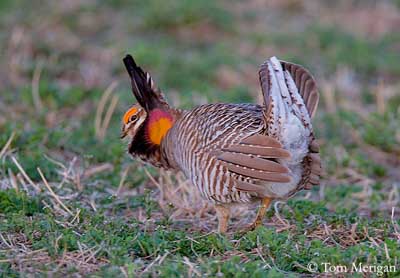
PROTECTION / THREATS / STATUS:
Greater Prairie Chicken is threatened by habitat loss and hunting, introduced mammals (foxes, feral cats…). They live in fragmented and restricted habitats where prairies are replaced by croplands. Hunting continues in four states.
Greater Prairie Chicken is classified as Vulnerable on the IUCN list.
Conservation measures are in progress, with establishment of reserves, control of predators and reintroduction of birds in protected areas.
Fr : Tétras des prairies
All : Präriehuhn
Esp : Gallo de las Praderas Grande
Ital : Tetraone maggiore delle praterie
Nd : Prairiehoen
Russe : Большой степной тетерев
Sd : Större präriehöna
Photographs by Tom Merigan
His website :
Tom Meriganís Photo Galleries
Text by Nicole Bouglouan
Sources:
HANDBOOK OF THE BIRDS OF THE WORLD Vol 2 by Josep del Hoyo-Andrew Elliot-Jordi Sargatal - Lynx Edicions - ISBN: 8487334156
FIELD GUIDE TO THE BIRDS OF NORTH AMERICA - National Geographic Society - ISBN: 0792274512
L’ENCYCLOPEDIE MONDIALE DES OISEAUX - Dr Christopher M. Perrins - BORDAS - ISBN: 2040185607
All About Birds (Cornell Lab of Ornithology)
Wikipedia (Wikipedia, The Free Encyclopedia)